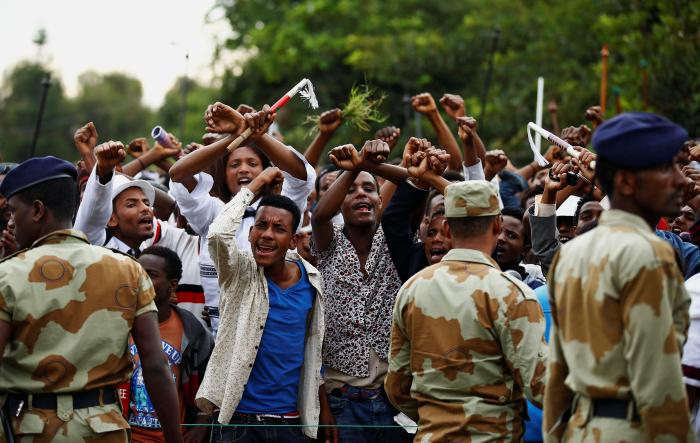
The war in Ethiopia’s northern Tigray region has cooled down since the signing of a peace deal on November 2.
But a separate conflict is intensifying further south in Oromia, where civilians are suffering as anti-government rebels step up attacks.
Oromo Liberation Army (OLA) rebels were previously confined to the fringes of western and southern Oromia, Ethiopia’s largest region. But analysts say the Tigray war created a security vacuum that has helped the OLA expand its long-running insurgency.
The security situation is now “fast deteriorating”, the UN’s aid coordination agency, OCHA, warned in a report last month. Hundreds of thousands of civilians have been uprooted and essential services are not functioning in some conflict-affected areas.
“We were afraid [that] the kinds of things you see in the media were happening in our city,” said Oromia resident Naol Tesfaye, describing an OLA attack in November. He said the group briefly seized his town, Nekemte, before melting into the countryside.
The OLA feeds off grievances among the Oromo, Ethiopia’s largest ethnic group. They account for around 40 per cent of the population but claim a history of oppression. Resentment has festered further under current Prime Minister Abiy Ahmed, who is himself an Oromo.
The government has responded to the rebellion with a counterinsurgency offensive. But the state-appointed Ethiopian Human Rights Commission has documented extrajudicial killings by government troops.
Ethnically based massacres are also increasing. The OLA is accused of targeting Amharas who live in Oromia, while ethnic militias from the Amhara region, which borders Oromia, have killed Oromo civilians. Many hundreds, if not thousands, have died.
Frustrated at the situation, Oromo lawmakers from Abiy’s ruling Prosperity Party wrote a letter last month to the prime minister’s office and the speaker of the national parliament, demanding a peace deal similar to the one in Tigray.
Among the authors was Buzayehu Degefa, whose constituency in Oromia’s East Wollega region is badly affected by the conflict. Degefa told The New Humanitarian that the situation cannot be resolved through military means.
“The government has been trying to defeat the group through military operations for three or four years and still there is no solution,” he said. “That is why we need another plan. We are demanding a peace deal brokered by a third party like the African Union.”
Until recently, the OLA mostly conducted small-scale hit-and-run operations. It has raided banks and conducted kidnappings to fund operations that include targeted assassinations against government officials and police officers.
The conflict has gone mostly unnoticed outside of Ethiopia amid heavy focus on the northern Tigray war, which has killed hundreds of thousands of people and dominated headlines about the country for the past two years.
But as implementation of the Tigray peace deal shows signs of progress: Tigrayan forces reportedly handed over their heavy weapons this week. Oromia has morphed into Ethiopia’s “most volatile region”, according to ACLED, a conflict monitoring group.
Violence is spreading to rural areas not far from the capital, Addis Ababa, and “the conflict is more or less engulfing the whole of the Oromo nation,” Merera Gudina, the chairman of the opposition Oromo Federalist Congress (OFC) party, says.
In western Oromia, the OLA is now controlling territory and pulling off increasingly complex attacks. And whereas it previously turned down new volunteers due to limited training capacity, it now holds big graduation ceremonies for recruits.
In recent months, there has been a flare-up in OLA attacks that may be linked to the Tigray peace deal, said a diplomat in Addis Ababa, who requested anonymity to preserve working relations with authorities.
“The OLA are stepping up their operations and expanding their control over some areas to score propaganda points before battle-hardened federal troops redeploy from the north,” the diplomat said.
Interviewed, several Oromia residents described deadly OLA raids in recent months. Naol from Nekemte – an urban hub centred on a major road junction – said it was dawn when he awoke to the sound of gunshots.
He said he spent six hours lying on the floor of his home as the OLA clashed with security forces. When he went outside, he saw the bodies of three people caught in the crossfire. “I had never heard gunshots before that day,” Naol said.
Nekemte residents said hundreds of OLA fighters took part in the November attack. Their target appeared to be local jails and police stations, where the rebels stole weapons and claimed to have released an unknown number of prisoners.
The regional government’s clumsy counterinsurgency strategy has made the conflict worse. Poorly trained soldiers have abused communities accused of harbouring rebels, while federal airstrikes have killed scores of civilians, rights investigators say.
- The New Humanitarian report











